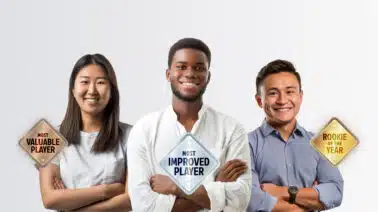
The good news is that very few of the skills you currently possess are going to be obsolete in the near future, if ever. That said, the work environments where those skills are currently valuable are probably going to change, and possibly even disappear. This makes it likely that at some point you’re going to need to prove that your existing skills are transferable skills. It also means you’re going to need to learn some new skills. These are the new rules of career change.
New Skills, Transferable Skills
As a simple example, you might have a great deal of experience writing press releases for print media. Those writing skills are still valuable, but now you’re going to have to learn to apply them to new types of content—blog posts, videos, infographics, social media posts, and more. You’re also going to have to learn some new skills, like how to use an analytics tool to monitor and track content performance, analyze results, develop actionable strategies, and create new, data-informed content that generates improved results.
“Your ability to get hired for a new role will ultimately depend on a mixture of new and transferable skills, and how well you enunciate the relevance and value of each.”
Here is another example—let’s say you have a significant amount of project management experience, but it was all acquired in on-site roles working with in-house teams. Those skills are still valuable, but you might have to learn to apply them to new scenarios, like managing a global workforce contributing remotely from multiple different time zones, and with varying degrees of commitment and availability (contractor, part-time, full-time, etc.). Successfully making this kind of transition can require mastering new collaboration tools like Slack, InVision, JIRA, or Trello, as well as conferencing tools like BlueJeans or Zoom. You may need to refine and improve your soft skills to better facilitate effective and conflict-free relationships with people in different locations, who may speak different languages, and have different backgrounds and cultural standards. You’ll probably have to up your time management game to juggle different time zones and work schedules. Once again, you’re looking at a mix of new and transferable skills being necessary to succeed.
Mastering The New Rules Of Career Change
Before proceeding, you may first want to ask, does any of this even apply to me? Am I in an industry or role that is poised for change significant enough that I need to be looking ahead towards a new career? According to a recent study by Oxford University, the answer could soon be “yes” for nearly half of us.
One critical issue this impending reality presents is a “skills gap”—the difference between the skills that industry needs from its employees, and the skills people actually have. The new rules of career change require auditing one’s one skill set carefully, honestly, and accurately.
The next step in the process is to determine which of the skills you currently possess are transferable skills, and then understanding whether these skills are adaptive, functional, or related to a specific subject. You’ll then need to spend some time researching other roles, to get a current and accurate sense of expectations and requirements.
Career Change ≠ Industry Change
Here’s an often-overlooked pro tip—start with the industry you’re already in. It’s a common misconception that career change necessitates industry change. That isn’t always true. There is virtually no industry on the planet that isn’t being impacted by transformational technologies like artificial intelligence and robotics. But that doesn’t mean they’re going away as industries. Agriculture isn’t going away. Transportation isn’t going away. Manufacturing isn’t going away. Healthcare isn’t going away. Still, these industries are changing, so your role could change, or even disappear. But, your expertise in the field stays with you.
Here’s an example that helps prove the point about career change and industry change. We recently published a story about a Udacity graduate named Kiyoko. After ten years in semiconductor processing, she felt she was seeing the writing on her career wall, and she knew she needed to make a change. She wanted to get into machine learning and data analysis, but she struggled, having no previous experience in the fields she was trying to break into. Ultimately, she succeeded by returning to the semiconductor industry—where she already had experience—and finding a new role within that space. She now works as a Data Scientist.
Learning New Skills
Identifying and enumerating your transferable skills—those skills and experiences that are potentially relevant to any career or role—should be both heartening, and revealing. On the one hand, you should hopefully be pleased to discover that you have a great deal going for you already. On the other hand, you’re probably going to come face-to-face with the fact that you have some critical gaps. That’s where learning new skills comes in.
The prospect of having to learn new skills may seem daunting, but fortunately, you live in an era where organizations like Udacity provide job-centric, skills-based learning programs that teach modern, in-demand skills in ways that are efficient, affordable, flexible, and laser-precise. With Udacity, you even have the added benefit of KNOWING that the skills you’re learning really are in-demand, because the programs are built in collaboration with companies who are actively hiring for these skills.
Demonstrating Career Proof Points
Consider the following quote (recently featured in a recent CareerBuilder article about transferable skills) from Lori Bumgarner, a career specialist and owner of career coaching firm paNASH:
“Transferable skills should always be illustrated with a result. If the use of your transferable skill helped make an improvement of any kind (i.e., increased revenue, saved time, increased customer satisfaction, etc.), you should include this on your application using numbers and figures to quantify your result (even if you have to approximate).”
The thinking behind this statement is essentially the same thinking that informs Udacity’s approach to learning—our students do real work, engage in real-world experiments, and build real projects, the results of which then populate exclusive portfolios that showcase a graduate’s core competencies. In short, newly-learned skills are “illustrated with results.” This is what project-based learning is all about—creating the examples that will function as your career proof points.
Realizations and Resolutions
Everything we’ve discussed here can be summarized as a simple list of realizations and resolutions:
- I will need to make a career change at some point in the future (realization)
- I have some existing skills that can transfer to a new role (realization)
- I must learn new skills to land a new role (resolution)
- I must demonstrate the value and relevance of both my new and transferable skills in order to successfully execute a career change (resolution)
Mastering the new rules of career change requires auditing existing skills for transferability, and learning new skills to fill in any gaps. It means getting the balance right between the two, and being able to demonstrate and communicate the value of each. Mastering the new rules of career change requires honest self-assessment, and focused research about roles and fields. It means planning ahead, and being strategic.
At Udacity, we offer programs that are expressly designed to help you successfully launch, advance, or change careers. You can always go it alone, but if you want the proven support of an organization dedicated to helping you realize your career dreams, consider Udacity.



